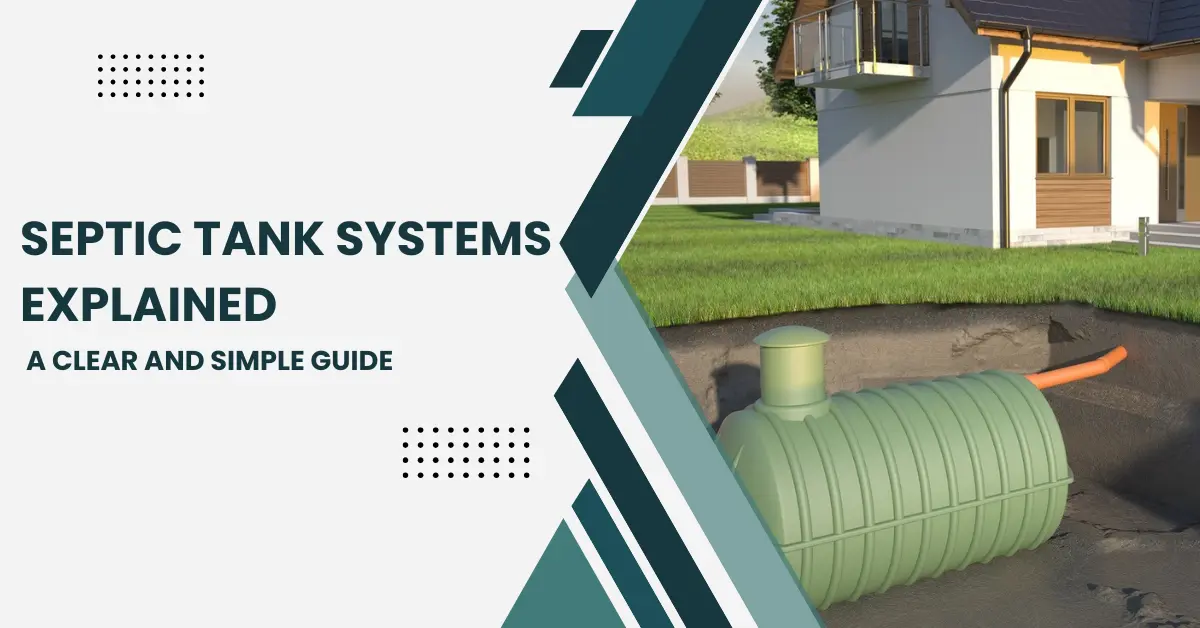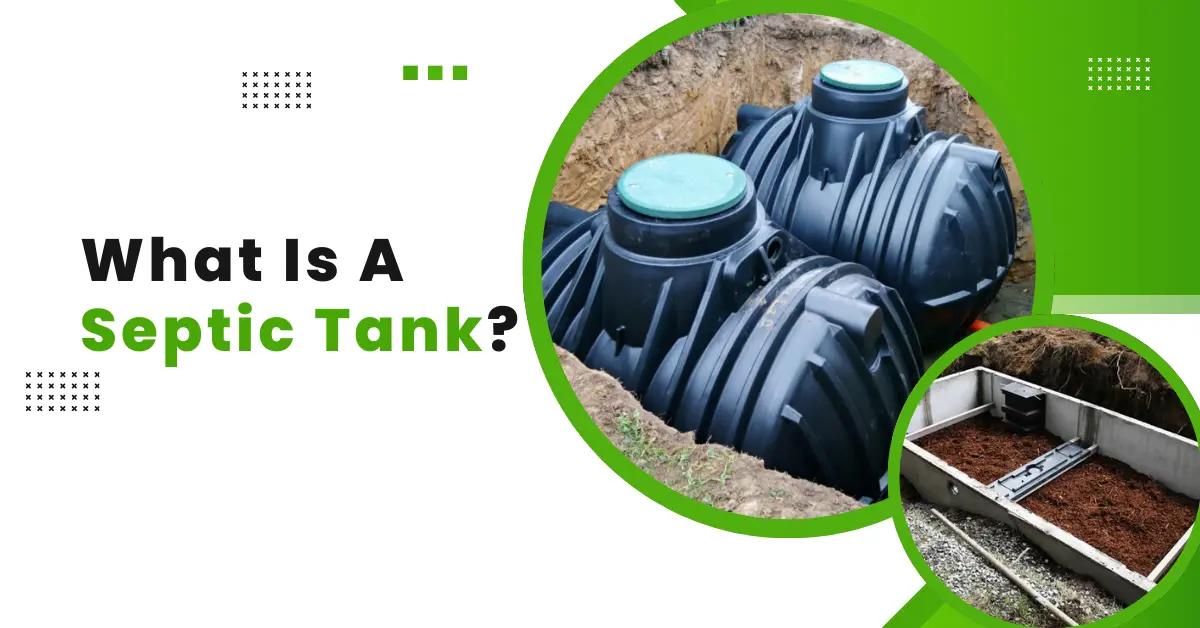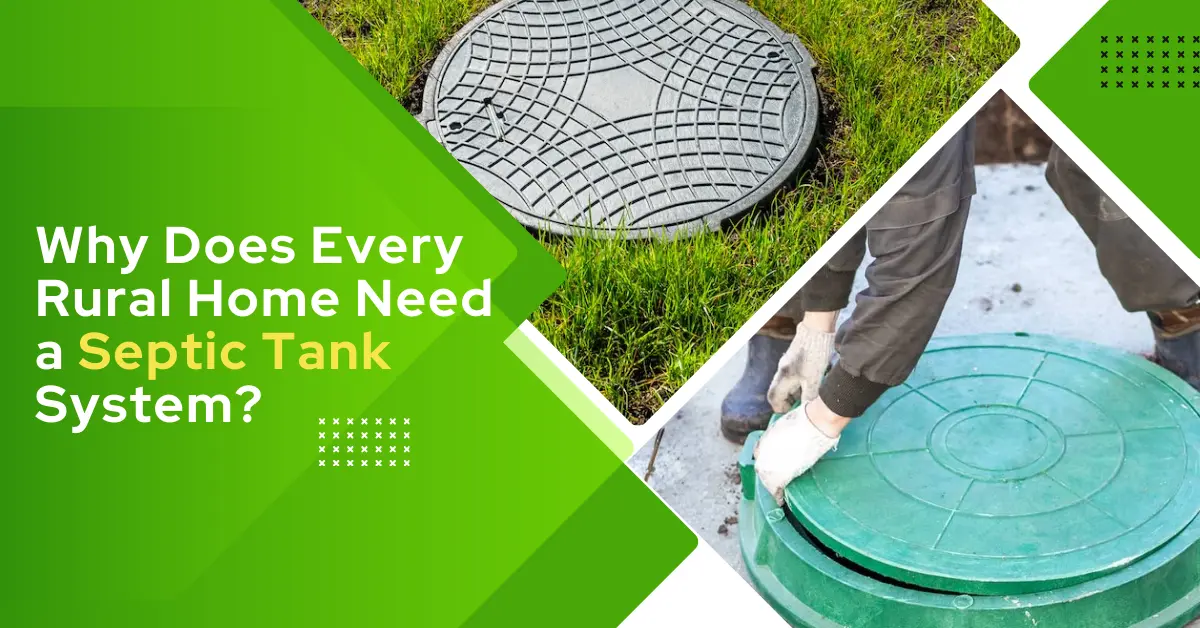If your home isn’t connected to a city sewer, then managing wastewater is critical. That’s where a septic tank system comes in. These underground systems treat waste on your property without needing city sewer lines.
So, how does a septic tank work?
A septic tank works by separating solids from wastewater. As the waste flows in, heavier solids settle to the bottom, lighter materials like grease rise to the top.
Anaerobic bacteria within the tank break down organic matter and convert about 50% of solids into liquid and gas. The remaining liquid flows into a drain field, while solids stay in the tank until removed
This guide gives you a simple, step-by-step look at how a septic system works, from the tank to the drain field, including its key parts, how it functions, how to maintain it, warning signs of trouble, and its impact on the environment.
Therefore, let’s get started!
What Is a Septic System?
A septic tank system is an underground wastewater treatment structure used in areas without centralized sewer systems.
It treats and disposes of household wastewater through a combination of natural processes and engineered components.
It consists of a septic tank that separates solids from liquids and a drain field that disperses treated liquid into the soil.
How Does a Septic Tank Work: A Step-by-Step Process
Here’s a breakdown of how a septic tank system works, step by step.
Step 1: Wastewater Leaves the House
All wastewater from your household, from toilets, sinks, showers, dishwashers, or washing machines, flows through one main pipe that connects your home to the septic system.
This flow usually moves on its own using gravity, so a pump is only needed if the ground is flat or slopes upward.
Step 2: Entry into the Septic Tank
Wastewater first enters the septic tank, a large, watertight container usually made from concrete, fiberglass, or polyethylene.
Inside the tank, there are inlet baffles that slow down and direct the incoming wastewater so it doesn’t disturb the waste already in the tank.
The tank holds the wastewater for 24 – 48 hours to let it naturally separate and break down.
Step 3: Waste Separation Occurs
As the wastewater sits undisturbed, it separates into three distinct layers.
- Top layer: Scum – oils, fats, grease, and lighter solids float to the top.
- Middle layer: Effluent – the relatively clear liquid that still contains some impurities.
- Bottom layer: Sludge – heavier solids settle to the bottom.
This natural settling process is key to preparing the wastewater for treatment in the soil.
Step 4: Anaerobic Digestion of Solids
Within the septic tank, anaerobic bacteria (bacteria that live without oxygen) start to break down the organic solids in both the scum and sludge layers.
Up to 50% of solids decompose into gases and liquids. It reduces the build-up of waste.
In addition, gases produced, such as methane, escape through a vent pipe in your home’s plumbing.
Step 5: Effluent Exits the Tank
Once the wastewater is partially treated, it exits the tank through an outlet baffle, which prevents solids from escaping.
The effluent (middle layer liquid) flows out of the tank into the next treatment stage, the drainfield.
Step 6: Effluent Distribution in the Drainfield (Leach Field)
The effluent travels through a system of perforated pipes laid in gravel-filled trenches called the drainfield or leach field.
These pipes distribute the effluent evenly into the soil. The drainfield must be carefully located and designed to ensure proper filtration and absorption.
Step 7: Final Filtration in the Soil
As the effluent percolates downward through the soil, it undergoes a final round of treatment.
Soil microbes remove pathogens, organic material, nutrients, and harmful bacteria. By the time it reaches groundwater, the wastewater is safely purified.
Key Components of a Septic System
Let’s delve into the key components of a septic system, with a comprehensive overview of each part and its function.
1. Sewer Line (Conveyance Line)
It transports wastewater from your home’s plumbing system to the septic tank.
This pipe collects all wastewater from toilets, sinks, showers, and appliances, and directs it to the septic tank for treatment.
2. Septic Tank
The septic tank acts as the primary treatment chamber, where solids settle and scum rises. It allows for partial decomposition.
This is typically made of concrete, fiberglass, or polyethylene. The tank holds wastewater long enough for solids to settle (forming sludge) and oils to float (forming scum).
Anaerobic bacteria break down a portion of the solids.
3. Inlet Baffle
Here, the inlet baffle directs incoming wastewater downward, minimizing disturbance of settled solids.
It’s located at the tank’s entrance. It slows the flow of wastewater, prevents agitation of the scum and sludge layers.
4. Outlet Baffle (Tee)
It prevents scum and solids from exiting the tank into the drainfield.
This one is situated at the tank’s exit. It ensures that only clarified effluent flows to the next stage and protects the drain field from clogging.
5. Effluent Filter
This filter traps small particles and prevents them from entering the drainfield.
This filter is installed at the outlet baffle. It enhances the quality of effluent and prolongs the lifespan of the drainfield.
6. Access Risers and Manholes
The manholes provide easy access to the septic tank for inspection and maintenance.
Risers extend from the tank to the ground surface, topped with secure lids. It facilitates routine pumping and inspections.
7. Tank Lids
Tank lids seal the septic tank and prevent odors and unauthorized access.
These covers are essential for safety and maintenance. It also ensures the system remains closed yet accessible when needed.
8. Distribution Box
Evenly distributes effluent to the drainfield lines.
This component ensures that wastewater is evenly dispersed across the drainfield. It promotes even absorption and prevents overloading in specific areas.
9. Drainfield (Leach Field)
This is the final treatment and dispersal of effluent into the soil.
It consists of perforated pipes laid in gravel-filled trenches. It also allows effluent to percolate through the soil, where it’s naturally filtered and purified.
10. Soil Absorption Area
This area acts as a natural filter and removes contaminants from the effluent.
The soil under the drainfield plays a crucial role in treating wastewater, utilizing microbial activity to eliminate pathogens and nutrients.
Septic Tank Maintenance
Here are a few maintenance tips for your septic tank health.
1. Recommended Pumping Frequency
According to the EPA’s Guide to Septage Treatment and Disposal, homeowners should have their septic tanks inspected and pumped every 3 to 5 years to ensure the system functions efficiently.
However, households with higher water usage or smaller tank capacities may require more frequent servicing.
It’s advisable to consult with a licensed septic professional to determine the optimal schedule for your specific situation.
2. Warning Signs Your Septic Tank Is Full or Failing
Being vigilant about the following signs can help prevent costly repairs.
- Slow drainage
- Pooling water
- Lush, green grass
- Gurgling sounds
- Unpleasant odors
3. Dos & Don’ts for Septic System Care
Dos
- Use water efficiently
- Maintain the drainfield
- Regular inspections
Don’ts
- Avoid flushing non-degradable items
- Limit chemical usage
- Never dispose of hazardous materials
- Don’t pour grease or oil down the drain
Environmental Impact & Safety of Septic Systems
Here are a few environmental impacts coming with a proper septic tank.
How Properly Maintained Septic Systems Protect Groundwater
When designed, installed, and maintained correctly, septic systems effectively treat household wastewater and safeguard groundwater resources.
The treatment process involves:
Primary Treatment: Solids settle in the septic tank, while oils and grease float. It allows the clarified effluent to exit.
Secondary Treatment: The effluent disperses into the drainfield, where soil microorganisms further break down contaminants before the water percolates into the groundwater.
This natural filtration process prevents harmful pathogens and nutrients from contaminating drinking water sources.
Risks of Neglect or Poor Installation
Neglecting maintenance or improper installation can lead to serious environmental and health hazards.
Groundwater Contamination
Failing systems can release untreated wastewater. It may containe nitrates, bacteria, and viruses into the soil, posing risks to drinking water.
Soil Degradation
Overloaded drainfields can become saturated. It leads to surface pooling and soil contamination.
Health Hazards
Exposure to untreated sewage can cause illnesses and unpleasant odors. It affects community well-being.
Economic Costs
Repairing or replacing failed systems can be expensive, and property values may decline due to environmental concerns.
Sustainable Practices for Septic System Management
To minimize environmental impact and ensure safety,
- Regular Maintenance
- Eco-Friendly Products
- Proper Waste Disposal
- Protect the Drainfield
- Water Conservation
FAQs
1. Does shower or laundry water go into the septic tank?
Yes. In a typical residential septic system, all wastewater from your household, including water from showers, sinks, bathtubs, washing machines, and toilets flows into the septic tank. This is known as “greywater” (from non-toilet sources) and “blackwater” (from toilets).
2. How do I know when my tank needs pumping?
Septic tanks generally need to be pumped every 3 to 5 years, but the frequency can vary based on household size, tank size, and water usage. Warning signs that your tank may need pumping include slow-draining sinks or toilets, gurgling plumbing sounds, sewage odors near drains or outside, and pooling water around the drain field.
3. Can a septic tank system freeze?
Yes, septic systems can freeze, especially in colder climates where components like pipes, tanks, or drain fields are not buried deeply enough or are underused during winter months. Frozen systems can lead to blocked pipes, system backups, or total failure.
4. What size septic tank do I need for my household?
Tank size depends on both the number of people living in the home and water usage habits. A general rule of thumb is:
- 1 – 2 bedrooms: 750 – 1,000 gallons
- 3 – 4 bedrooms: 1,000 – 1,250 gallons
- 5+ bedrooms: 1,500+ gallons
5. What are some DIY maintenance tips for keeping my septic system healthy?
DIY Septic System Maintenance Checklist:
- Monitor water usage.
- Use septic-safe products
- Keep the drain field clear
- Inspect tank lids and risers
- Divert rainwater
- Never flush
- Mark the tank location
6. How much does a septic system cost (installation, pumping, and repairs)?
Costs can vary widely depending on location, soil condition, and system size. On average:
- Installation: $3,000 – $10,000+ for a new system (including tank, drain field, and labor)
- Pumping: $250 – $600 every 3 to 5 years, depending on tank size and region
- Repairs: Minor fixes (like baffle replacement) may cost $100 – $500, while drain field replacement or tank repairs can exceed $5,000
Conclusion
Knowing how a septic system works, from wastewater entry to soil filtration, helps homeowners care for it better and avoid expensive problems.
We’ve covered its key components, the step-by-step process, signs of trouble, and even the environmental importance of keeping your system in good shape.
Routine maintenance isn’t just a recommendation; it’s essential. Pumping your tank every few years, conserving water, and avoiding harmful materials can extend the life of your system and protect your property.
A properly functioning septic tank plays a critical role in wastewater management. Learn why a septic tank is important to both your home and the environment.
While there’s plenty you can do yourself, don’t hesitate to bring in a licensed septic professional for inspections, repairs, or system planning.
Flush smart, live clean!





